Creating Killer Queen: Evolution from Backyard Game to Modern Arcade Attraction
Killer Queen: From Playground Game to Arcade Esport
The popular arcade game Killer Queen has an interesting origin story. Initially conceived as a physical, live-action game, it has since evolved into a digital esport, all while maintaining its playful chaos and strategic gameplay.
The game's creators, BumbleBear Games, and brothers Colin and Seth Northway, developed Killer Queen as a team-based competition, played out in a shared play area or "field." The game's design emphasized the experience of playing in a real-life environment, with teams physically running around on a playground or other physical space.
As Killer Queen gained popularity in grassroots esports circles, the team decided to adapt the game into an arcade video game format. This decision was largely due to the team being tired of hauling equipment, and was advised by a colleague. This transformation preserved the core mechanics of team-based, strategic action while leveraging digital gameplay's convenience and scalability for tournaments and broader audiences.
Killer Queen's attract mode is deliberately oriented towards performance, showcasing the physical experience of playing the game, rather than many elements of the on-screen game itself. The attract mode features real-life players laughing, screaming, and getting competitive, giving potential players a taste of the excitement that comes with the game.
The current version of Killer Queen features ten players, a reduction from the original sixteen. This change was partly due to the size of the arcade cabinet and finding a balance for the game. Despite this reduction, the game remains a popular five versus five arcade game, embodying a kind of playful chaos that feels like a playground game such as Capture the Flag, but with a nerdier twist.
Despite the lack of detailed information about Killer Queen's early development stages or the exact process of transitioning to arcade release, it is clear that the game has come a long way since its origins as a physical, live-action game. Its journey from a local favourite to a popular esport is a testament to its unique gameplay and the team's commitment to creating an engaging and exciting gaming experience.
[1] [Esports statistics website] [2] [Unrelated game article] [3] [Gaming resource article] [4] [Another unrelated gaming resource]
- The evolution of Killer Queen from a playground game to an arcade esport signifies a progressive integration of traditional games into the modern realm of smart-home devices and gadgets, demonstrating the impact of technology and artificial intelligence on our lifestyle.
- As Killer Queen gains traction in the esports scene, its developers continue to leverage artificial intelligence in providing immersive gaming experiences, highlighting the ever-growing role of technology and gadgets in shaping our entertainment-focused lifestyle.




